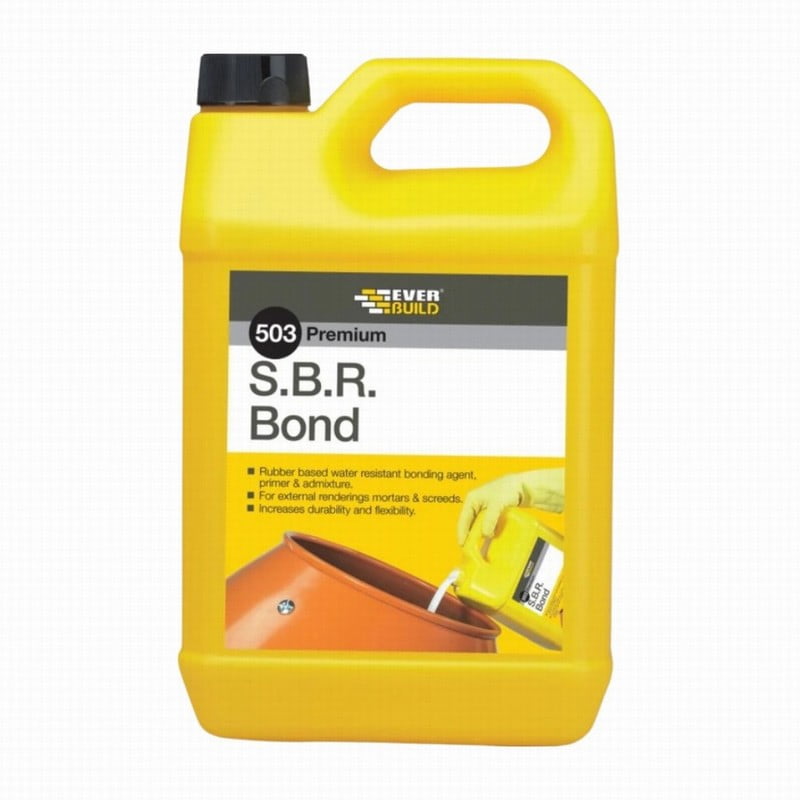Description
Everbuild SBR Bond is a latex based, water resistant bonding agent and admixture for use in areas subject to humidity, dampness and continuous water contact. Improves water resistance of cement mixtures by forming a reinforcing polymer that increases long term durability and flexibility of the mix on renderings and floor screeds. Great in landscaping for fixing copings and pier caps that are vulnerable to be dislodged when just using conventional mortar. SBR Bond can also be used to form a bond bridge when laying slabs that can sometimes be difficult to bond to the bed, such as slate and porphyry. To make up this slurry mix with cement and apply to the back of the slab with a trowel. EVERBUILD SBR BOND is a white liquid, which has numerous uses as an admixture, primer, bonding agent and sealer. Polymer Emulsions of this type have been used extensively over the last 20 years by the building industry as an admixture for cement and concrete applications, including repair and renovation, surfacing of floors and bonding generally. It contains anti-foam to control the density of cementitous mixes.
Benefits
- Greatly improved adhesion to a wide range of substrates including dense concrete, steel, tiles etc.
- Mixes may be applied in much thinner sections
- Excellent resistance to water and water vapour
- A high level of resistance to salt permeation
- Much improved toughness and flexibility
- Reduced surface dusting of concrete
- Greatly improved resistance to many chemicals- ideal for use in dairy parlours etc.
- Reduced water: cement ratio for equivalent workability
- Improved frost resistance
- SBR Bond is also freeze thaw stable.
- As an admixture for mortar/screeds/renders.
- As a bonding agent for screeds/renders.
- As a primer/sealer in tiling applications.
- As a flexibliser for cementicious based tile adhesive when tiling on wooden/asphalt floors.
- In addition, SBR Bond has the advantage over PVA bonding aids in that it is not adversely affected in wet conditions and is therefore recommended for exterior use.
- In common with other SBR products, SBR BOND is not suitable for coloured exterior decorative renders which will not be subsequently overpainted. Its poor UV resistance may cause discolouration
Surface preparation
All surfaces must be clean, dry and free from dust, grease and other contaminents.
Application
Flooring: This concerns the use of SBR Bond in screeds and toppings over background concrete. Adding SBR Bond to a floor screed or topping gives the following advantages:
- A low water:cement ratio allows a minimum of delay when overcoating is required.
- Reduced permeability to liquids.
- Improved chemical, abrasion and impact resistance .
- Resistance to dusting.
- Thinner screeds, achieving reduction in weight and savings in materials.
- Excellent slip resistance.
- Goods underlay for epoxy surfacing.
- SBR Bond has a long and successful track record of use in the construction industry.
- Sand should be well washed and sharp. The grade of sand will depend upon the mix design.
- Cement Portland, High Alumina and sulphate resisting cements are compatible with SBR Bond. Portland cement should be fresh but cool. Cement containing air set lumps should not be used.
- Coarse aggregate e.g. Granite chippings. These should be dust free.
- Air entraining agents These should not be used.
| Screed | Topping | |
| O.P.C | 1 | 1 |
| Moist Sand | 3.5 | 1.75 |
| 3mm Washed Granite | 0 | 1.75 |
| SBR Bond | 0.2 | 0.2 (ie 10 litres per 50kg bag of cement) |
| Water | As required | As required |
All parts are by volume of uncompacted material.
Coverage rate: As a rough guide, 1.2 litres of SBR BOND will cover 1m² of 12mm thickness using the above mixes.
Mixing: Mixing procedures for topping and screeds containing SBR Bond are similar to those used to conventional compositions, with gauging water partly replaced by SBR Bond. However, mixing time should be minimised to limit air entrainment. Mixing should be carried out in a forced action mixer. The usual procedures is to pre-mix sand and cement in the mixer, pour in the SBR Bond, mix for 1 – 3 mins, then slowly add water to the required consistency. NB. Over addition of water causes rapid thinning of latex modified mortars owing to the plasticising effect of the latex.
Pot life: The mix has a pot life of approximately 30 minutes and batch size should be calculated accordingly.
Application
- Apply topping or screed onto wet or tacky primer.
- Compact and level with screed bar.
- Finish with steel float. It is essential that the topping or screed is finished as the work proceeds.
- The topping or screed would be cured for 1 – 2 days using conventional techniques. Curing should be started quickly after application.
Notes: Joints in the screed or topping should coincide with the joints in the background. It is easier to lay the mix if the ambient temperature is below 25°C. If overcoating the screed, oleoresinous floor finishes should be avoided. It the water drop test indicates the presence of water repellants, it may be more suitable to use and epoxy primer in place of the latex/cement primer.
Cleaning equipment
All tools should be cleaned immediately after use with water because hardened SBR Bond modified toppings and screeds have excellent adhesion and are therefore difficult to remove. Solvents such as white spirit used with coarse wire wool help to remove partially hardened mortar.



Reviews
Reviews (0)
There are no reviews yet.